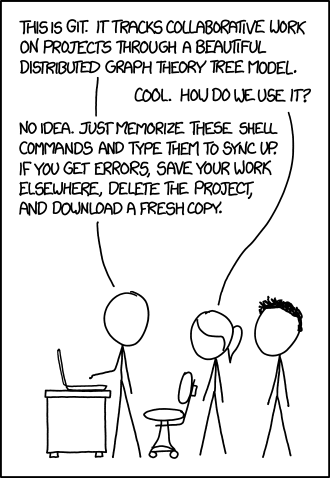git s a brilliant version control system—but it can be confusing. As this classic xkcd comic shows, many users just memorize a few commands and panic when things go wrong:
This tutorial takes a different approach: you will learn git by using it. Commands reveal info step by step, so you won't skip anything and hopefully, you'll have fun along the way 😉 The tutorial lives in the "tutorial" folder (see build instructions below). Since it contains spoilers, don't explore the rest of this repo (like the src folder) until you are done with the play through!
Build instructions:
git clone https://github.com/miallo/nuggit.git
cd nuggit
./build.sh
cd tutorial
ls
# Look! Another README!and the fun can begin! The whole "game" will now take place in this folder alone. Let's start by reading the README.md inside of that folder 😊
Q: Why can't you get the "tutorial" folder with git clone <url> but have to build it?
A: That is a good question and you will figure out the answer the more you get into the quests (many of which are impossible in a fresh clone)…
Alternatively: If you don't want to run this "build"-script yourself (it basically just executes a bunch of git commands to create the folder "tutorial" and fills it with all the information you need), you can download it:
curl https://nuggit.lohmann.sh/tutorial.zip --output tutorial.zip
unzip tutorial.zip
tar --extract --file=tutorial.tar
cd tutorial
ls
# Look! Another README!and then you are ready! The whole "game" will now take place in this folder only. Let's start by reading the README.md in that folder 😊
Note: for some cursed reason thanks to GitHub, the folder must also be inside of a tarball to remain playable…
- diff (--staged/@{u})
- add
- commit (-m)
- show
- switch (-c)
- push
- pull
- log
- rebase
- merge
- cherry-pick (range/--abort)
- reset (--hard/--soft)
- restore (--staged/--source/--ours)
- revert
NOTE: If you just want to learn, you don't need to continue reading 😉
If you want to work on this, architecture contains a short introduction on how this project is structured.
The main implementation is found in ./build.sh. Under src/ there are many of the text snippets / hooks that are used in build.sh.
By default ./build.sh does not show the git output to avoid leaking information. If you get an error you can run it again with -v/--verbose.
If you want to get the hooks printed, you can uncomment debug_hooks at the end of ./build.sh.
Alternatively it can be useful to avoid having to "play the game" to a specific place every time and instead run the tests up to a point. Insert debug_hooks test && exit in the testing script at the place where you need it and then take a look at the "tutorial" folder and play the step in question.
To run the tests you simply need to execute:
./test.shIt has three levels of verbosity: by default it just prints the test cases, but if run with -v it will also output every expect. If run with -v -v it will additionally print every output of the commands it executed.
WARNING: It will build the tutorial for you, since it has to reset the state inbetween to check incompatible "paths" (test with triggering the LocalCodeExecution trap, or not). That means it does not matter into which state you bring the tutorial directory before the run - it will be deleted and replaced by a fresh build before the first test is run.
For writing tests there is a tiny testing framework (loosely inspired by jest). It is by far not feature complete. Example:
sum() {
a="$1" b="$2"
echo "$(( a + b ))"
}and the test code:
it 'adds 1 + 2 to equal 3' '
expect "sum 1 2" to contain "3";
'(Yes, right: it is so "tiny", it does not even have a "to equal" action yet, but only a "stdout contains substring" assertion... So far it was all we needed, but feel free to extend it!)
